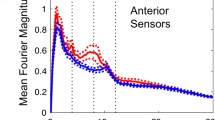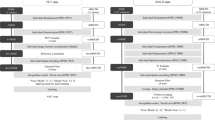Abstract
Purpose
Music can induce different emotions. However, its neural mechanism remains unknown. The aim of this study was to use functional magnetic resonance imaging (fMRI) and position emission tomography (PET) imaging for mapping of neural changes under the most popular music in healthy volunteers.
Methods
Blood-oxygen-level-dependent (BOLD) fMRI and monoamine receptor PET imaging with 11C-N-methylspiperone (11C-NMSP) were conducted under the popular music Gangnam Style and light music A Comme Amour in healthy subjects. PET and fMRI images were analyzed by using the Statistical Parametric Mapping software (SPM).
Results
Significantly increased fMRI BOLD signals were found in the bilateral superior temporal cortices, left cerebellum, left putamen and right thalamus cortex. Monoamine receptor availability was increased significantly in the left superior temporal gyrus and left putamen, but decreased in the bilateral superior occipital cortices under the Gangnam Style compared with the light music condition. Significant positive correlation was found between 11C-NMSP binding and fMRI BOLD signals in the left temporal cortex. Furthermore, increased 11C-NMSP binding in the left putamen was positively correlated with the mood arousal level score under the Gangnam Style condition.
Conclusion
Popular music Gangnam Style can arouse pleasure experience and strong emotional response. The left putamen is positively correlated with the mood arousal level score under the Gangnam Style condition. Our results revealed characteristic patterns of brain activity associated with Gangnam Style, and may also provide more general insights into the music-induced emotional processing.





Similar content being viewed by others
References
Salimpoor VN, van den Bosch I, Kovacevic N, McIntosh AR, Dagher A, Zatorre RJ. Interactions between the nucleus accumbens and auditory cortices predict music reward value. Science. 2013;340(6129):216–9.
Korhan EA, Uyar M, Eyigor C, Hakverdioglu Yont G, Celik S, Khorshid L. The effects of music therapy on pain in patients with neuropathic pain. Pain Manag Nurs Off J Am Soc Pain Manag Nurses. 2014;15:306–14.
Allred KD, Byers JF, Sole ML. The effect of music on postoperative pain and anxiety. Pain Manag Nurs Off J Am Soc Pain Manag Nurses. 2010;11(1):15–25.
Good M, Stanton-Hicks M, Grass JA, Cranston Anderson G, Choi C, Schoolmeesters LJ, et al. Relief of postoperative pain with jaw relaxation, music and their combination. Pain. 1999;81(1−2):163–72.
Shook A, Marian V, Bartolotti J, Schroeder SR. Musical experience influences statistical learning of a novel language. Am J Psychol. 2013;126(1):95–104.
Gangnam Style. http://en.wikipedia.org/wiki/Gangnam_Style_by_country#Cultural_impact. 2016.
Salimpoor VN, Benovoy M, Larcher K, Dagher A, Zatorre RJ. Anatomically distinct dopamine release during anticipation and experience of peak emotion to music. Nat Neurosci. 2011;14(2):257–62.
Wagner Jr HN, Burns HD, Dannals RF, Wong DF, Langstrom B, Duelfer T, et al. Imaging dopamine receptors in the human brain by positron tomography. Science. 1983;221(4617):1264–6.
Morris ED, Yoder KK. Positron emission tomography displacement sensitivity: predicting binding potential change for positron emission tomography tracers based on their kinetic characteristics. J Cereb Blood Flow Metab. 2007;27(3):606–17.
Ishibashi K, Ishii K, Oda K, Mizusawa H, Ishiwata K. Competition between 11C-raclopride and endogenous dopamine in Parkinson’s disease. Nucl Med Commun. 2010;31(2):159–66.
Paterson LM, Tyacke RJ, Nutt DJ, Knudsen GM. Measuring endogenous 5-HT release by emission tomography: promises and pitfalls. J Cereb Blood Flow Metab. 2010;30(10):1682–706.
Nyberg S, Eriksson B, Oxenstierna G, Halldin C, Farde L. Suggested minimal effective dose of risperidone based on PET-measured D2 and 5-HT2A receptor occupancy in schizophrenic patients. Am J Psychiatry. 1999;156(6):869–75.
Gefvert O, Lundberg T, Wieselgren IM, Bergstrom M, Langstrom B, Wiesel F, et al. D(2) and 5HT(2A) receptor occupancy of different doses of quetiapine in schizophrenia: a PET study. Eur Neuropsychopharmacol. 2001;11(2):105–10.
Zhang Y, Chen Q, Du F, Hu Y, Chao F, Tian M, et al. Frightening music triggers rapid changes in brain monoamine receptors: a pilot PET study. J Nucl Med Off Publ Soc Nucl Med. 2012;53(10):1573–8.
Sheehan DV, Lecrubier Y, Sheehan KH, Amorim P, Janavs J, Weiller E, et al. The Mini-International Neuropsychiatric Interview (M.I.N.I.): the development and validation of a structured diagnostic psychiatric interview for DSM-IV and ICD-10. J Clin Psychiatry. 1998;59 Suppl 20:22–33. quiz 4–57.
Soloff PH, Price JC, Meltzer CC, Fabio A, Frank GK, Kaye WH. 5HT2A receptor binding is increased in borderline personality disorder. Biol Psychiatry. 2007;62(6):580–7.
Tian M, Chen Q, Zhang Y, Du F, Hou H, Chao F, et al. PET imaging reveals brain functional changes in internet gaming disorder. Eur J Nucl Med Mol Imaging. 2014;41(7):1388–97.
Frost JJ, Rosier AJ, Reich SG, Smith JS, Ehlers MD, Snyder SH, et al. Positron emission tomographic imaging of the dopamine transporter with 11C-WIN 35,428 reveals marked declines in mild Parkinson’s disease. Ann Neurol. 1993;34(3):423–31.
Friston KJ, Holmes AP, Worsley KJ, Poline JP, Frith CD, Frackowiak RS. Statistical parametric maps in functional imaging: a general linear approach. Hum Brain Mapp. 1995;2(4):189–210.
Bengtsson SL, Ullen F. Dissociation between melodic and rhythmic processing during piano performance from musical scores. NeuroImage. 2006;30(1):272–84.
Muranishi M, Inokawa H, Yamada H, Ueda Y, Matsumoto N, Nakagawa M, et al. Inactivation of the putamen selectively impairs reward history-based action selection. Exp Brain Res. 2011;209(2):235–46.
Jolij J, Meurs M. Music alters visual perception. PLoS ONE. 2011;6(4):e18861.
Konoike N, Kotozaki Y, Miyachi S, Miyauchi CM, Yomogida Y, Akimoto Y, et al. Rhythm information represented in the fronto-parieto-cerebellar motor system. NeuroImage. 2012;63(1):328–38.
Sutoo D, Akiyama K. Music improves dopaminergic neurotransmission: demonstration based on the effect of music on blood pressure regulation. Brain Res. 2004;1016(2):255–62.
Acknowledgements
This work is partly sponsored by Grants from the National Key Research and Development Program of China (2016YFA0100900), National Key Basic Research Program of China (2013CB329506), National Science Foundation of China (NSFC) (no. 81425015, 81271601) and Zhejiang Provincial Natural Science Foundation of China (LR13H180001). No other potential conflict of interest relevant to this article was reported.
Author information
Authors and Affiliations
Corresponding author
Ethics declarations
Conflict of interest
The authors declares no conflict of interest.
Ethical approval
All procedures performed in studies involving human participants were in accordance with the ethical standards of the institutional and/or national research committee, and with the 1964 Helsinki Declaration and its later amendments or comparable ethical standards.
Informed consent
Informed consent was obtained from all individual participants included in the study.
Additional information
Qiaozhen Chen, Ying Zhang and Haifeng Hou contributed equally to this work.
Electronic supplementary material
Below is the link to the electronic supplementary material.
ESM 1
(DOCX 21 kb)
Suppl. Fig 1
(GIF 254 kb)
Suppl. Fig 2
(GIF 295 kb)
Suppl. Fig 3
(GIF 280 kb)
Rights and permissions
About this article
Cite this article
Chen, Q., Zhang, Y., Hou, H. et al. Neural correlates of the popular music phenomenon: evidence from functional MRI and PET imaging. Eur J Nucl Med Mol Imaging 44, 1033–1041 (2017). https://doi.org/10.1007/s00259-017-3614-7
Received:
Accepted:
Published:
Issue Date:
DOI: https://doi.org/10.1007/s00259-017-3614-7




